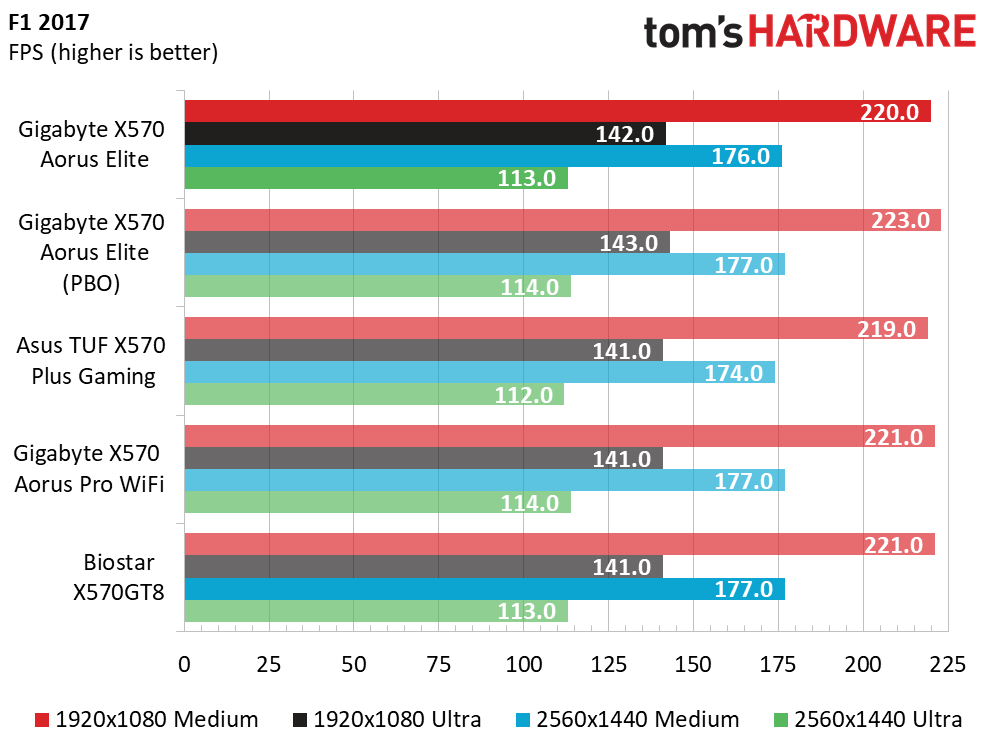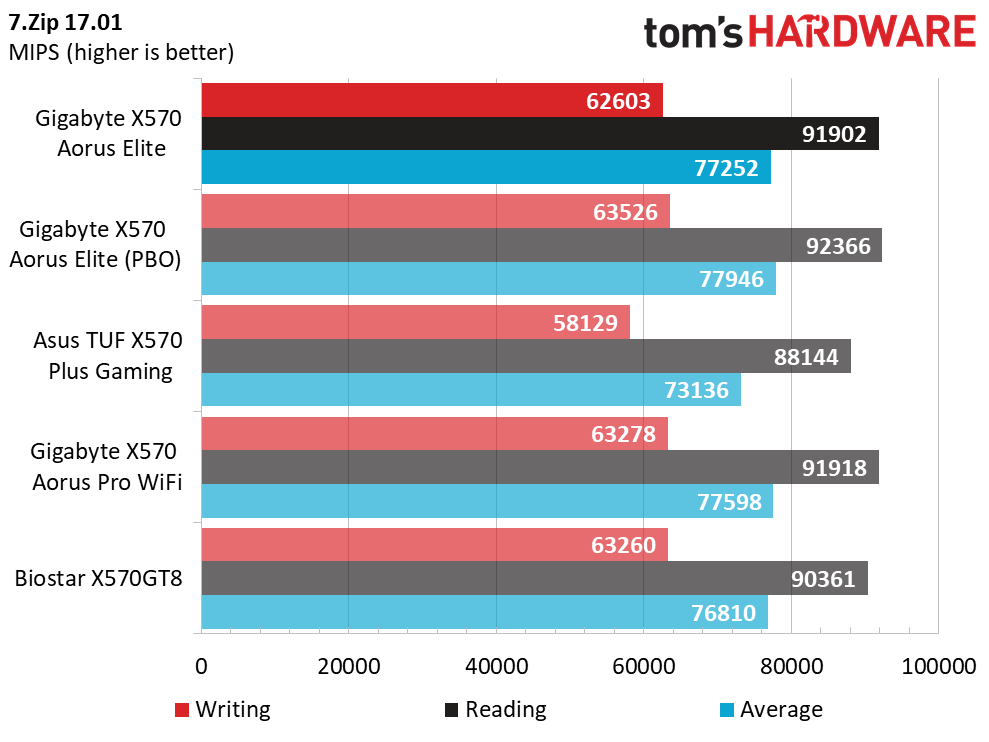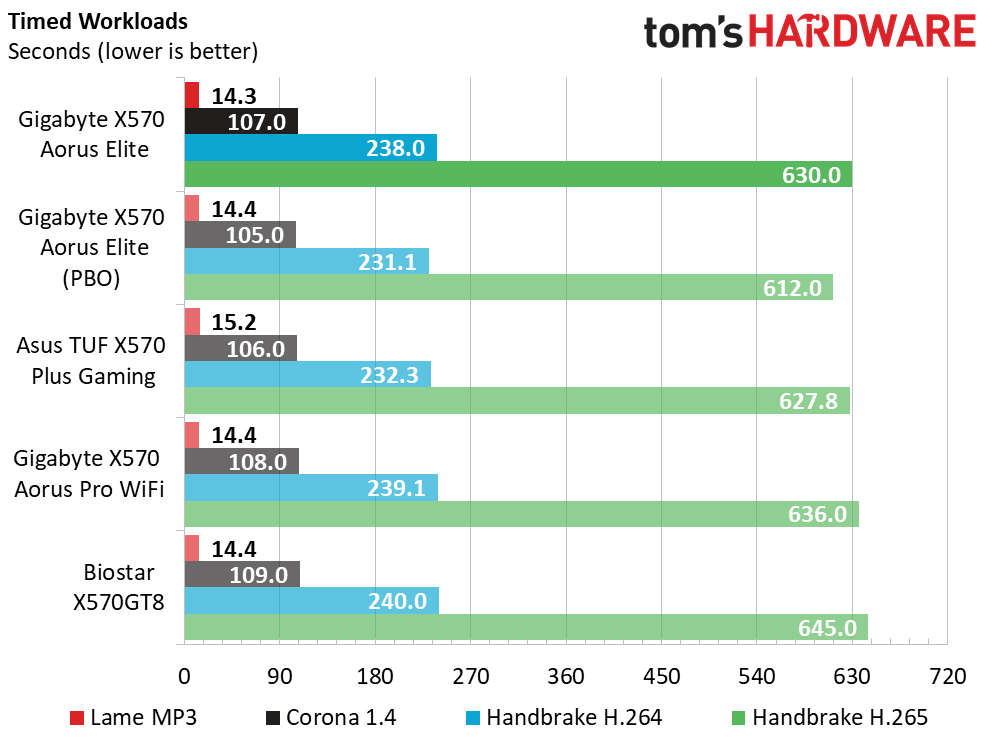Gigabyte X570 Aorus Elite Motherboard Review: Sub-$200 Goodness
Why you can trust Tom's Hardware
Benchmark Results and Final Analysis
All standard benchmarks and power tests are performed using the CPU’s stock frequencies (including stock AMD Turbo), with all of its power-saving features enabled. Optimized defaults are set in the BIOS and the memory set. The memory is manually set up to run at DDR4 3200 MHz ( the base spec for Zen 2), at 16-18-18-38 primary timings.
Synthetic Benchmarks
Synthetics are a great tool to figure out if a board is running out of spec, as identical settings should produce extremely similar performance results. Advanced memory timings are the one place where motherboard makers can still optimize for either stability or performance though, and those settings can impact some testing.







In our synthetic set of tests, the Gigabyte X570 Aorus Elite performed admirably, trading blows with the other X570 models we’ve tested. All results were within general run variance difference, with no anomalous data points. In general, Precision Boost Overdrive (PBO) showed some improvement across most tests, but not much overall.
3D Games


Checking in on the games, here we also see parity among the other boards tested and do not find any appreciable differences. PBO didn’t do much for gaming, especially at the higher resolution.
Timed Applications


The timed applications also show little difference overall. A tenth of a second separates the LAME results, while the Corona result shows just a couple of percent difference between worst to first. The same goes for Handbrake testing. PBO resulted in an improvement here of a couple percent, which is one of the better results using that feature.
Overall Performance
Overall performance differences between the boards we tested were negligible. The Gigabyte X570 Aorus Elite’s worst showing was .4% slower than the average and best was 2% faster. We could rerun these tests and get a slightly different story. So for all intents and purposes, the boards performed the same overall.
Power and Relative Energy Efficiency


When talking power consumption, the Gigabyte X570 Aorus Elite idled at 60W, the lowest result by several watts, and used 145W in Prime 95 Small FFTs. The average was 103W, the least amount of power overall. When enabling PBO on this board, the load use jumped to 215W in the same test.
Get Tom's Hardware's best news and in-depth reviews, straight to your inbox.
Overclocking
I was excited to finally get overclocking and see what this inexpensive motherboard was able to accomplish. After a bit of tweaking, the X570 Aorus Elite was able to push our Ryzen 7 3700X to 4.16 GHz at 1.32V. Anything beyond this point yielded a near-instant stoppage of AIDA64’s stress test. Our EVGA CLC 240 cooler was able to keep the 3700X below 90 degrees celsius, which was adequate. But for those who would like to push larger chips, chances are a 240mm AIO of any type won’t be sufficient.
On the memory side of things, we were able to load up our G.Skill Trident Z Neo 4x8GB DDR4 3600 16-16-16-36 sticks without issue. Much beyond that value, the memory divider hits 1:2 situation and overall performance tends to drop without much in the way of increased speeds. AMD said DDR4 3600 is the sweet spot, and we're able to reach that without issue.


Overall, the Gigabyte board clocked well and brought the chip to its limit. We’ll test overclocking on the Asus TUF Gaming X570-Plus Wi-Fi and other boards as time goes on and see if they can do a better job, but from what we’ve seen in our own testing and elsewhere, the CPU itself is putting a lid on things.
Final Thoughts
The Gigabyte X570 Aorus Elite has proven itself to be a solid board with a sub-$200 price point, and it’s currently one of just a few boards under that threshold for X570. The Elite showed good performance overall, and was able to handle everything our suite threw at it when running stock, using PBO as well as manual overclocking. So don’t let the entry-level price fool you.
The board includes a total of six SATA ports, dual PCIe 4.0 x4 M.2 slots (one with a heatsink) and a good number of USB ports, including USB 3.1 Gen 2 ports out back and the front panel. However, it does not have a USB Type-C port on the rear IO. If that is a requirement, it will have to come from your chassis’ front panel.
If we compare this board to the Asus TUF Gaming X570-Plus Wi-Fi (also priced at $199) it comes with eight SATA ports, 8-channel audio (using a modified ALC1200 codec), and included Wi-Fi. That’s a more generous collection of features at the same price point. If you need the extra SATA ports and Wi-Fi, the Asus will be the better choice on that front.
But if you’re going to be using Ethernet, and don’t need a full cadre of SATA connectors, your choice may come down to aesthetics. On that front, the Aorus Elite’s theme agnostic approach won’t offend anyone and likely not wow them either. And if you like this board’s looks and would like wireless connectivity, the X570 Aorus Elite Wi-Fi costs about $10 extra, or $209.
Image Credits: Tom's Hardware
MORE: Best Motherboards
MORE: How To Choose A Motherboard
MORE: All Motherboard Content

Joe Shields is a staff writer at Tom’s Hardware. He reviews motherboards and PC components.
-
alan.campbell99 I ended up going for this motherboard shortly after the Ryzen 3000 CPUs dropped. It's working well for me so far. My considerations were cost, PCIe16 slots and m.2 heatsink scheme. I wanted two PCIe16s so I could add in my SAS card, I wanted separate m.2 heatsinks that didn't require messing with the chipset heatsink, I also didn't need lots of SATA as I use two NVME drives and a bunch of SAS SSDs I acquired. No optical drive in this build either so presently not using any SATA ports.Reply -
atombombe Recently upgraded to a Ryzen 3700X cpu and needed a motherboard. After searching a lot I finally chose to Gigabyte Aorus Elite X570. First Gigabyte product I own. Not afraid of buying more from the Gigabyte brand in the future.Reply
What made me buy this board over other products was the Intel lan, Realtek ALC1200 audio codec and also every review states that the board had good VRMs. Not that I'm a huge overclocker, but I chose good VRMs because of future expand-ability. I might get some better CPU with more cores and then need the extra power on the board.
It has been very easy to build the computer. Everything just worked. Put in DDR4 3200 CL14 ram, chose XMP in bios and it has been running without any hickups! -
robert40 it is funnyReply
"Elite was able to push our Ryzen 7 3700X to 4.16 GHz at 1.32V. Anything beyond this point yielded a near-instant stoppage of AIDA64’s stress test "
this cpu is 3.6gh -4.4 gh without overlocking:) -
SovereignKnight Replyrobert40 said:it is funny
"Elite was able to push our Ryzen 7 3700X to 4.16 GHz at 1.32V. Anything beyond this point yielded a near-instant stoppage of AIDA64’s stress test "
this cpu is 3.6gh -4.4 gh without overlocking:)
That is 4.4 GHz on ONE or TWO cores. The rest of the cores are running @ ~ 3.6-3.8 GHz.
The overclock in this review is 4.16 GHz on ALL cores.
It takes a hell of allot of power to push all cores to 4.16 GHz, vs. just 1 or 2 cores at 4.4 GHz.
That also takes more voltage, in turn creating more heat.
The benefit in this case for overclocking all cores to 4.16 GHz is, you get one hell of a multi threaded boost for any application that will use more than one or two cores. -
raposa ReplySovereignKnight said:That is 4.4 GHz on ONE or TWO cores. The rest of the cores are running @ ~ 3.6-3.8 GHz.
The overclock in this review is 4.16 GHz on ALL cores.
It takes a hell of allot of power to push all cores to 4.16 GHz, vs. just 1 or 2 cores at 4.4 GHz.
That also takes more voltage, in turn creating more heat.
The benefit in this case for overclocking all cores to 4.16 GHz is, you get one hell of a multi threaded boost for any application that will use more than one or two cores.
Do you mean a higher Tier motherboard, would provide more power, thus providing better mult-thread perfomance? Thus maximizing potential of multicore processores, like 3900x/3950x? -
robert40 Reply
You are right! Sorry.I am new on amd (ryzen 5 3600) from intel I5 3570k (z77) and from 3400mhz to 4200 all core (4 core) without + voltage or anything else.......just change the multiper.On 4300 just work 3 core and 4th core must put just 4200mhx.But i am sure + little voltage will fine.and more....SovereignKnight said:That is 4.4 GHz on ONE or TWO cores. The rest of the cores are running @ ~ 3.6-3.8 GHz.
The overclock in this review is 4.16 GHz on ALL cores.
It takes a hell of allot of power to push all cores to 4.16 GHz, vs. just 1 or 2 cores at 4.4 GHz.
That also takes more voltage, in turn creating more heat.
The benefit in this case for overclocking all cores to 4.16 GHz is, you get one hell of a multi threaded boost for any application that will use more than one or two cores.
so amd is different(:
but still the best value.... -
kadir8804 Reply
check your configuration I have that board and that micro at 4.25 1.25v without problemsrobert40 said:it is funny
"Elite was able to push our Ryzen 7 3700X to 4.16 GHz at 1.32V. Anything beyond this point yielded a near-instant stoppage of AIDA64’s stress test "
this cpu is 3.6gh -4.4 gh without overlocking:) -
Ancient Alien Wow, I must have bad luck. I have been building my own systems since 1996. Purchased the X570 Aorus Elite in Dec 2019. BIOS erased the partitions on 5 HHDs totaling 16TB. Returned for a replacement and new board wouldn't recognize any drives but one. Came with f4 BIOS, so I downloaded the f20 BIOS to flash. BIOS recognized the USB drive, but I couldn't save or load from it. Sometimes, while booting, the BIOS screen would come up without pressing the delete key and would do this several times before I finally got the OS to load. Had random system freeze ups that became more frequent. Ended up calling it a $200 loss and replaced it with a MSI MEG X570 Tomahawk WiFi and the system behaves well now. No more Gigabyte products for me.Reply
